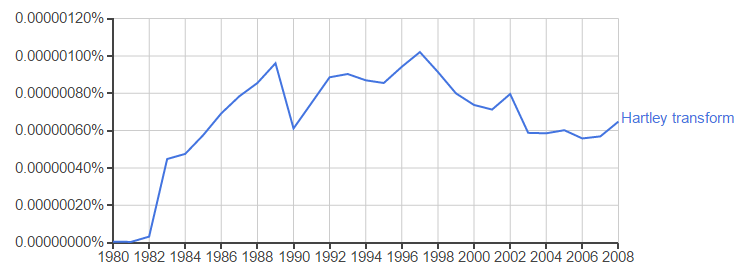You are probably interested in the real discrete transforms. Here are the basis functions for a transform of length 6. The inverse transforms are weighted sums of these basis functions, and the forward transform figures out the weights given the time domain sequence. A reconstruction of the time domain sequence by the inverse transform is exact. The discrete transforms don't actually involve the continuous functions shown below but rather their samples at integer time indices (here 0, 1, 2, 3, 4, 5).
As a service to those who prefer to see equations, the discrete Hartley transform $H_k$ and discrete Fourier transform $X_k$ of $x_k$, where $k = 0, \dots, N-1$ are defined by:
$$H_k = \sum_{n=0}^{N-1} x_n \left[ \cos \left( \frac{2 \pi}{N} n k \right) + \sin \left( \frac{2 \pi}{N} n k \right) \right]\\
X_k = \sum_{n=0}^{N-1} x_n \left[ \cos \left( \frac{2 \pi}{N} n k \right) - i \sin \left( \frac{2 \pi}{N} n k \right) \right],$$
where $i$ is the imaginary unit.
Hartley

Figure 1. Hartley transform basis functions are harmonic sinusoids. Each basis function is a sum of sine and cosine.
Being harmonic means that the frequency of each is an integer multiple of the lowest non-zero frequency. Some of the sinusoids have frequency greater than the Nyquist frequency.
Or as discrete sequences: [1, 1, 1, 1, 1, 1] (yellow), [1, 1.366, 0.366, -1, -1.366, -0.366] (black), [1, 0.366, -1.366, 1, 0.366, -1.366] (green), and so on.

Figure 2. Hartley basis functions, constructed from the discrete basis functions by perfect bandlimited interpolation assuming that the sequences repeat forever. The discrete Hartley transform could alternatively be expressed directly with these functions, colored the same as in Fig 1.
Except for the special cases of frequency 0 and π, the aliased Hartley basis functions come in pairs of harmonic equal frequency sinusoids that are 90 degree apart, just like in the real discrete Fourier transform below. Except for scaling and phase shifts (with one scaling constant and one phase shift constant for each pair), the basis functions are identical to those of the real discrete Fourier transform.
Fourier

Figure 3. Real discrete Fourier transform basis functions are harmonic cosines and sines, here colored the same as the equivalent scaled and phase-shifted Hartley basis functions in Fig. 2.
For frequencies 0 and π there are no sine basis functions because their samples would be zero-valued and would never contribute to the weighted sum in the inverse tramsform. Unlike with the Fig. 1 formulation of Hartley transform, the discrete Fourier transform basis functions stay within the Nyquist frequency limit.
Popularity of Hartley
The fast Hartley transform algorithm came out in 1984, but there has been no significant increase in its popularity since.

Figure 4. Google Ngram of Hartley transform counts the relative frequency of the word pair in literature as it developed over the years.




